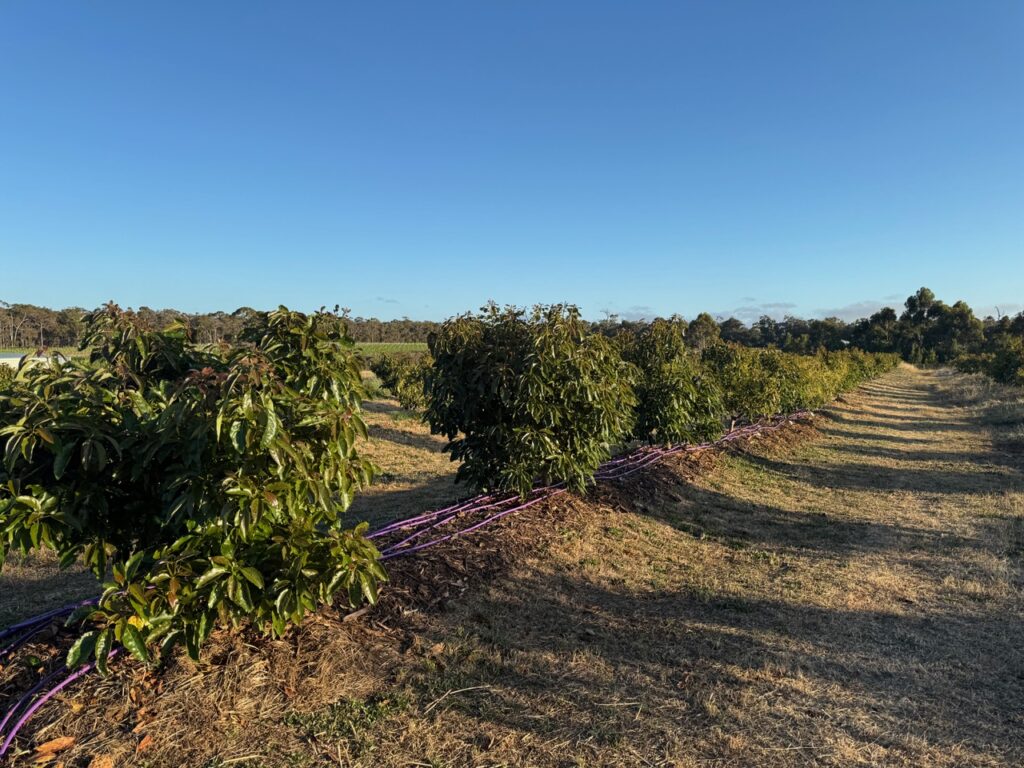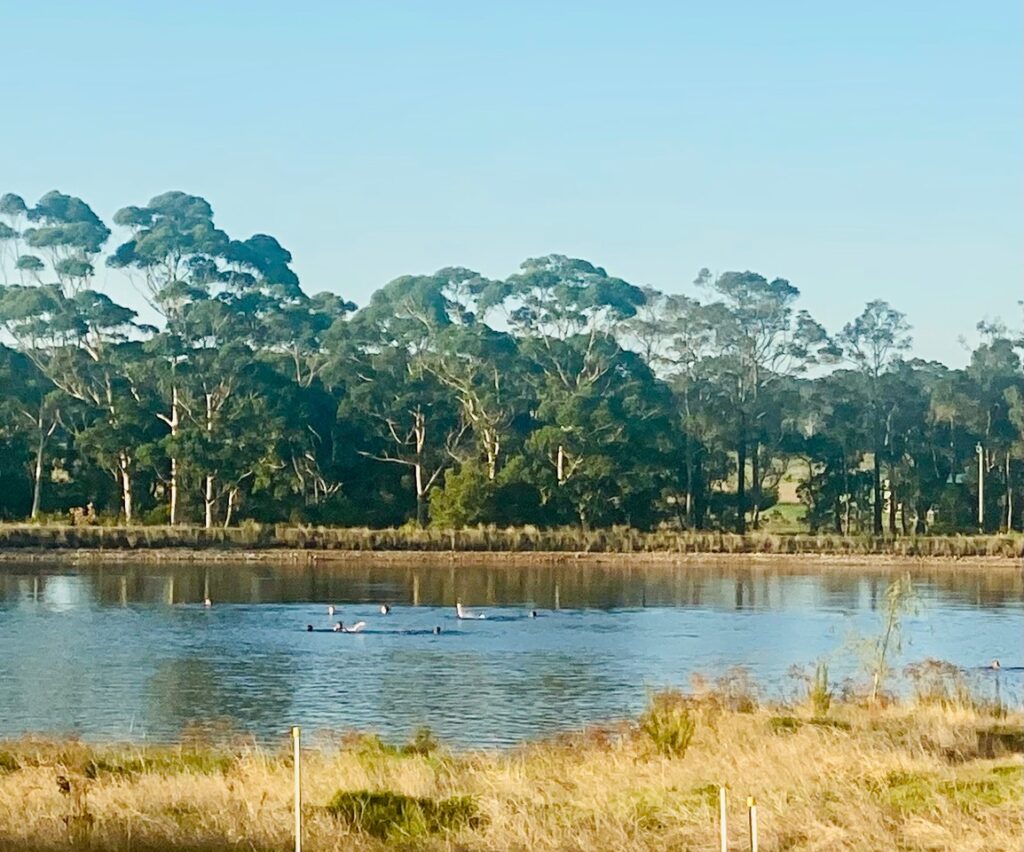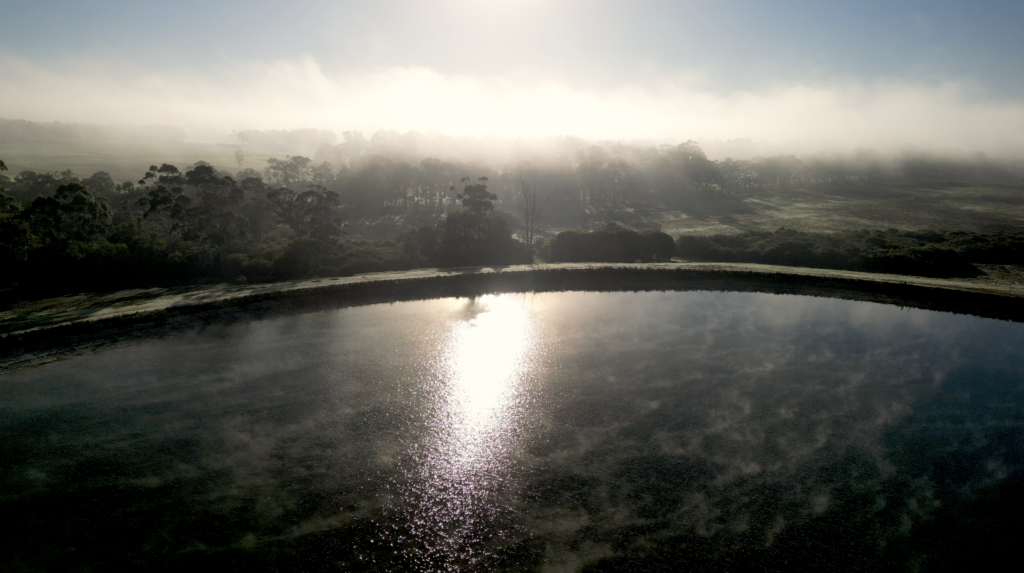Some of you will remember my last newsletter article on Ecovillage Water in May ’24, after the driest seven months on record where we only received 40mm of rain at the Ecovillage. I stated in this article that historically, very dry summers are often followed by wetter than average winters, so we have our fingers crossed. Well, the rain gods delivered! We’ve received 1084mm since the 1st of May, including the wettest August on record, with 327mm recorded in the Ecovillage, slightly more than double the BOM Witchcliffe August average of 158mm.
All of our three magnificent dams were overflowing by early August. The central dam was the first to start overflowing, on July 28, followed one day later with the northern dam, and the southern dam on August 5.

Central and northern dams at their lowest point at the end of last summer (the driest on record)
I was very pleased with how close together they were as it confirmed that we have got our overall water balance right. We draw most of the water from the southern dam, and pump it to the residential clusters and ag lots with a very large solar pump, which does an outstanding job. The northern dam has a mains powered pump station which runs from 10pm to 1am on smart power, and tops up any tanks that weren’t filled by the solar pump during sunlight hours. This is particularly useful on overcast days. The central dam is connected to the solar pump as well, but we don’t intend to draw any water from it unless necessary as it’s our conservation dam due to a native freshwater plant that encourages a lot of water birds to graze there (I’ve seen up to 11 swans grazing in this dam together).
Over the course of this year, we have pumped 21.7ML from the southern dam and 7.2ML from the northern dam. Including estimated use for this month of December, we have used the following volumes of water:
| Area | Annual Water Budget | 2024 Total Usage (inc Dec estimates) |
| Residential Clusters | 33ML | 19.7ML |
| Public Open Space | 5ML | 5.4ML |
| Vineyard | 6ML | 3.5ML |
| Ag Lots | 40ML | 0.29ML |
| Evaporation | 93ML | 90ML |
| Totals | 177ML | 119ML |
As you can see in the table above, this equates to a total usage of 119ML from the annual budget of 177ML. The total capacity of all three dams is 250ML. This budget ensures that the two main dams that we pump water from are left at least 1/3 full at the end of the dry season. Due to the diminishing grade of the dam walls, 1/3rd full will look and feel a lot fuller than they are.
As you can see, evaporation uses more than the total we’ll use throughout the Ecovillage when fully built and occupied, and whilst we have budgeted for this, I’m keen to explore ways to reduce it, naturally.
The reason I say naturally, is because the main methods used around the world are floating plastic discs or chemicals that increase the surface viscosity. Therefore, I’m keen to explore natural methods like wind breaks and native water plants such as azolla. However, we also don’t want to lose our beautiful views and swimming pools in summer, when reduced evaporation would be ideal.
Azolla, is a floating water fern native to Australia. It has a symbiotic relationship with cyanobacteria that enables it to fix atmospheric nitrogen. This makes it a valuable mulch or addition to your compost. It also has a very high protein content, which makes it great feed for ducks and chickens. You’ve probably seen it floating on the rice paddies of Asia, where it’s used extensively for soil fertility and feeding ducks. I’m going to start a trial on our Waste Water Treatment pond, which only receives excess recycled/treated water in winter months.
The total surface area of our three dams is 82,479m2 (8.25Ha). We can measure the evaporation rate, with reasonable accuracy, by surveying our central dam each month (we’re very fortunate to have a retired surveyor in the Ecovillage, who’s also my water monitoring and meter reading volunteer, Alex Jolly – for whom we’re all very grateful). The maximum drop in surface level in the central dam was 1.14m at the end of April 2024. The water level then increased to 1.00m by the end of May after 138mm of rainfall. Then to 580mm in June after a further 156mm of rain, before starting to overflow at the end of July after a further 287mm.
These numbers give us a good idea of the size of the catchment, which gets clearer as the wet months go by, as the early rains are being soaked into the ground. It always surprises me how much water runs into our dams, particularly the largest two, which have larger catchments. We measured the southern dam’s flow rates at 4,000,000 litres/day (during the wettest days of July & August), using a V notch weir before we built the Ecovillage, and it has only increased since due to the impervious layers within the village.
This means that the total amount of water we pumped out of the southern dam this year – 21ML (including an estimate for this month), plus around 30ML of evaporation in that dam, can be replaced within 13 days in July & August!
This is a big reason why I chose this magnificent location to build the Ecovillage, as we have loads of water, and best of all, we’re at the very top of the catchment. Being at the top of the catchment enables us to manage our water quality and avoid being flood prone with a limited catchment. The further down-stream the larger the potential catchment in very high rainfall events, thereby increasing flood potential.
Current Water Use
Our residential cluster water budgets, set at 136 KL per annum per lot, provide a generous amount of water for the size of our community gardens, if used efficiently. As per our cluster bylaws, all EUA’s (veggie patches) and common gardens have to be waterwise, which in our climate means watering via drippers, not sprinklers (except the small lawn area in each cluster). Well mulched common garden beds and street trees won’t need to be watered more than once a week between October to December, and twice a week from January to February, then back to once a week from March to April. We will hardly use any water from May to September whilst the dams are filling from rainwater.
It’s been great to see our Stage 1 clusters, which are now close to fully built, getting serious about minimising water use. Just about all veggie patches have eliminated the use of sprinklers (all have to this year) and most residents are getting serious about making sure they only use their fair share of water. 1C are definitely setting the standard as our most efficient cluster — very well done to all involved!
Agricultural lots and Vineyard
We don’t expect all of the Ag lots to use their annual 3.0 ML allowance and the Ag lots can’t trade water, so I expect an Ag lot surplus each year. I’m very pleased with the significant reduction in water use in the vineyard after we completely replaced the irrigation pipes and drippers towards the end of last summer. This season I expect the vineyard will only use around half of its annual quota.

Public Open Space
The public open space (POS), which was handed over to the Shire in January, was using too much water last summer, but I am very pleased with the huge effort the Shire has made towards reducing their water use since, including the recently re-mulching of most of their gardens throughout the Ecovillage. I expect that they’ll use their quota each year.
Community Avocado Orchard
I expect the avocado orchard will be watered entirely from recycled Waste Water this dry season, which is a wonderful outcome for our community. From black water to clean water with approved (DWER) traces of N, P & K, which our avocado trees love! TMC are now treating an average of 20,600L/day, from the 115 occupied homes + trades associated with the additional 36 homes under construction (assume = 5 homes). Our homes average two people each, which means we’re averaging around 85L/day/person. This also means that our 814 avocado trees will receive around 25L/day each, which in our soil type is close to perfect! As you can see in the photo taken this week, below, they are thriving!
The waste water treatment plant has an independent 30kW solar system, so it makes more energy than it consumes to provide a completely closed loop water cycle within the Ecovillage. Not to mention providing all of the water needs for delicious, nutrient dense, high quality, protein from the community avocado orchard! It’s been a huge amount of work, but I’m very pleased with how well it’s going!

Ecovillage residents enjoying the Stingray (named for it’s shape) on a hot summer’s day.
Monitoring of our Ecovillage wide water use forms just a small part of the overall monitoring that we hope to conduct and share as we settle into life in the Ecovillage. We developed our annual water budgets with the worst type of season in mind, so it’s very encouraging to see that the Ecovillage is tracking so well after the driest consecutive seven months on record! However, we all love swimming in our dams over summer as well, so our monitoring confirms for us that best practice irrigation/efficiency and nutrient management are the name of the game, and for the Ecovillage residents reading this, keep mulching!

